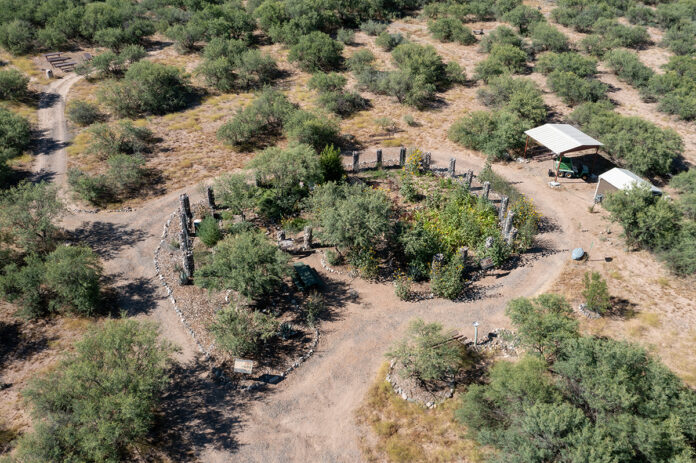Rob Estrada, the Verde Valley Archaeology Center’s ethnobotanist, led visitors throughout the center’s Native American Heritage Pathway and Garden on Saturday, July 1.
Estrada and VVAC’s volunteers use the garden to demonstrate traditional methods of farming and experiment with new techniques.
A visiting Hopi artisan had suggested they try a section of dry farming, a traditional technique that relies solely on rainfall without using irrigation. Estrada saw this done on the Hopi Reservation and experimented with it in the garden. When he failed to germinate any plants the first year, he analyzed the soil and found that it lacked organic material and minerals. He brought in leaves, manure and compost to rejuvenate the dead soil, and the dry farm now produces pre-colonial plants, such as cushaw squash and corn.
After Estrada established the dry garden, many native volunteer species colonized it, including bee plant, larkspur, fleabane, wormwood and desert marigolds. Estrada said that these plants are now “on autopilot” and require little attention from him.
Estrada is also experimenting with waffle gardening, which involves layering soil, manure, leaves and compost to encourage organic activity in the soil. A little berm is built around these layers to trap moisture.
The postcolonial section of the garden, which consists of crops native to the Americas but not to Arizona, contains jalapeños from central Mexico, butternut squash from the Northeast and sweet corn from the Eastern seaboard.
In another, irrigated, section of the garden, Estrada has planted landrace cultivars, or varieties specialized for the local environment, which is the opposite of commercial monoculture farming.
Estrada noted that the northern Apache used the technique of complementary plantings, seeding a combination of different species in a small plot of land and walking away from it rather than constantly tending to their crops. He again likened this to the crops being on autopilot, which was a common practice in many semi-agrarian and small agrarian societies prior to the formation of early states.
Estrada contrasted this practice with that of the Hopi, who typically separate their crops and grow them in different plots of land, which he said is workable for people who have a small plot of land and want to do small-scale farming.
“If there’s ever food shortages in the future, folks are going to have to grow food on their property,” Estrada said. “It may not be a luxury and may be something they have to do.” He mentioned the victory gardens of WWII.
The garden uses ancestral seeds. The red dye amaranth plant at the garden is of an ancestral variety, grown from seeds recovered at an archaeological site that germinated after hundreds of years. Estrada likened the ancestral seeds to little time capsules of DNA that contribute to maintaining biodiversity.
“I tell people I go to the gym and I’m at church at the same time,” Estrada said of the experience of gardening. “I believe we see God in nature. It’s physical work. I’m exercising and in contact with living things all day long and it feels really healthy both physically, mentally and spiritually.”
Estrada spoke of the importance of having a living, interactive portion of the center and remembered watching the expressions of a group of children on a field trip who saw irrigation canals opened up for the first time. He would like to add culinary events in the future, potentially by having people from local reservations give demonstrations on food preparation.
“Gardening and farming are really healthy activities,” Estrada said. “Farming is a lot of work … for me, it’s really a balance between the physical, spiritual and the psychological.”
The garden is located on Homestead Parkway off Finnie Flat Road.



